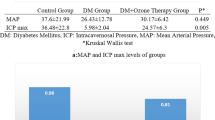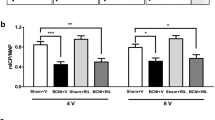Abstract
A polyhalogenated aromatic hydrocarbon, 2,3,7,8-tetrachlorodibenzo-p-dioxin (TCDD), is one of the most potent toxic environmental pollutants. Decreases in spermatogenesis and the ability to conceive and carry a pregnancy to term are the most sensitive signs of reproductive toxicity by TCDD in the mammal, but no report of its effect on the erectile function exists. We performed this study to investigate the effect of TCDD on the erectile function. New Zealand white rabbits were treated intraperitoneally with 1 μg/kg of TCDD. At 4 (Gr I) and 8 (Gr II) weeks after the administration of TCDD, cavernosal tissues were harvested for strip study in the organ bath and testes were prepared for histologic examination. Compared to the maximal amplitude of 17.1±4.12 mN in normal control (Gr III), the contractions to cumulative concentrations of NE (10−8–10−4 M) were significantly decreased to 6.57±1.34 and 5.45±1.01 mN in Groups I and II, respectively. Compared to 51.12±7.38% in Gr III, relaxation to cumulative concentration (10−8–10−4 M) of acetylcholine was significantly decreased to 17.25±2.17% (Gr I) and 9.73±2.17% (Gr II) at a concentration of 10−4 M, respectively. Compared to 75.12±13.18% in Gr III, relaxation to cumulative concentration (10−8–10−4 M) of SNP was significantly decreased to 31.49±7.89% (Gr I) and 18.54±6.12% (Gr II) at a concentration of 10−4 M, respectively. Histologically, intracavernosal fibrosis, abnormal subtunical deposition of fat and decreased sinusoidal space with consequent increase of trabecular smooth muscle contents were identified in TCDD-treated groups. In TCDD-treated animals, seminiferous tubules showed a decrease of germ cells with vacuolar degeneration and apoptotic cells. Spermatids were hardly seen. These results suggest that TCDD inhibits spermatogenesis and has a potential harmful effect on erectile function via changes of corpus cavernosum histology and smooth muscle physiology.
This is a preview of subscription content, access via your institution
Access options
Subscribe to this journal
Receive 8 print issues and online access
$259.00 per year
only $32.38 per issue
Buy this article
- Purchase on Springer Link
- Instant access to full article PDF
Prices may be subject to local taxes which are calculated during checkout







Similar content being viewed by others
References
Guo M, Joiakim A, Dudley DT, Reiners JJ . Suppression of 2,3,7,8-tetrachlorodibenzo-p-dioxin (TCDD)-mediated CYP1A1 and CYP1B1 induction by 12-O-tetradecanoylphorbol-13-acetate: role of transforming growth factor beta and mitogen-activated protein kinases(1). Biochem Pharmacol 2001; 62: 1449–1457.
Roman BL, Peterson RE . In utero and lactational exposure of the male rat to 2,3,7,8-tetrachlorodibenzo-p-dioxin impairs prostate development. 1. Effects on gene expression. Toxicol Appl Pharmacol 1998; 150: 240–253.
Roman BL, Timms BG, Prins GS, Peterson RE . In utero and lactational exposure of the male rat to 2,3,7,8-tetrachloro-dibenzo-p-dioxin impairs prostate development. 2. Effects on growth and cytodifferentiation. Toxicol Appl Pharmacol 1998; 150: 254–270.
Ohbayashi T et al. Dioxin induces a novel nuclear factor, DIF-3, that is implicated in spermatogenesis. FEBS Lett 2001; 508: 341–344.
Chahoud I, Hartmann J, Rune GM, Neubert D . Reproductive toxicity and toxicokinetics of 2,3,7,8-tetrachlorodibenzo-p-dioxin. 3. Effects of single doses on the testis of male rats. Arch Toxicol 1992; 66: 567–572.
Johnson L et al. Reduced Leydig cell volume and function in adult rats exposed to 2,3,7,8-tetrachlorodibenzo-p-dioxin without a significant effect on spermatogenesis. Toxicology 1992; 76: 103–118.
Kim W et al. Panax ginseng protects the testis against 2,3,7,8-tetrachlorodibenzo-p-dioxin induced testicular damage in guinea pigs. BJU Int 1999; 83: 842–849.
Henry TR et al. Early life stage toxicity of 2,3,7,8,-tetra-chlorobenzeo-p-dioxin in zebrafish (Danio rerio). Toxicol Appl Pharmacol 1997; 142: 56–68.
Schmidt JV, Bradfield CA . Ah receptor signaling pathways. Annu Rev Cell Dev Biol 1996; 12: 55–89.
Andreasen EA et al. Tissue-specific expression of AHR2, ARNT2, and CYP1A in zebrafish embryos and larvae: effects of developmental stage and 2,3,7,8- tetrachlorodibenzo-p-dioxin exposure. Toxicol Sci 2002; 68: 403–419.
Cantrell SM et al. Correlation of 2,3,7,8- tetrachlorodibenzo-p-dioxin-induced apoptotic cell death in the embryonic vasculature with embryotoxicity. Toxicol Appl Pharmacol 1998; 148: 24–34.
Dalton TP et al. Dioxin exposure is an environmental risk factor for ischemic heart disease. Cardiovasc Toxicol 2001; 1: 285–298.
Moon DG et al. Bisphenol A inhibits penile erection via alteration of histology in the rabbit. Int J Impot Res 2001; 13: 309–316.
Poland A, Knutson JC . 2,3,7,8-Tetrachlorodibenzo-p-dioxin and related halogenated aromatic hydrocarbons: examination of the mechanism of toxicity. Ann Rev Pharmacol Toxicol 1982; 22: 517–554.
Safe SH . Comparative toxicology and mechanism of action of polychlorinated dibenzo-p-dioxins and dibenzofurans. Ann Rev Pharmacol Toxicol 1986; 26: 371–399.
Shabsigh R . The effects of testosterone on the cavernous tissue and erection. World J Urol 1997; 15: 21–26.
Traish AM et al. Effects of castration and androgen replacement on erectile function in a rabbit model. Endocrinology 1999; 140: 1861–1868.
Jevtich MJ, Khawand NY, Vidic B . Clinical significance of ultrastructural findings in the corpora cavernosa of normal and impotent men. J Urol 1990; 143: 289–293.
Wespes E et al. Corporeal veno-occlusive dysfunction: predominantly intracavernous muscular pathology. J Urol 1997; 157: 1678–1680.
Goldstein AMB, Padma-Nathan H . The microarchitecture of the intracavernosal smooth muscle and the cavernosal fibrous skeleton. J Urol 1990; 144: 1144–1146.
Andersson KE, Wagner G . Physiology of penile erection. Physiol Rev 1995; 75: 191–236.
Holmquist F et al. Some pre- and postjunctional effects of castration in rabbit isolated corpus cavernosum and urethra. J Urol 1994; 152: 1011–1016.
Baba K . Effects of testosterone on smooth muscle in the isolated rabbit corpus cavernosum penis. Nippon Hinyokika Gakkai Zasshi 1993; 84: 1783–1790.
Author information
Authors and Affiliations
Corresponding author
Rights and permissions
About this article
Cite this article
Moon, D., Lee, K., Kim, Y. et al. Effect of TCDD on corpus cavernosum histology and smooth muscle physiology. Int J Impot Res 16, 224–230 (2004). https://doi.org/10.1038/sj.ijir.3901060
Received:
Revised:
Accepted:
Published:
Issue Date:
DOI: https://doi.org/10.1038/sj.ijir.3901060



